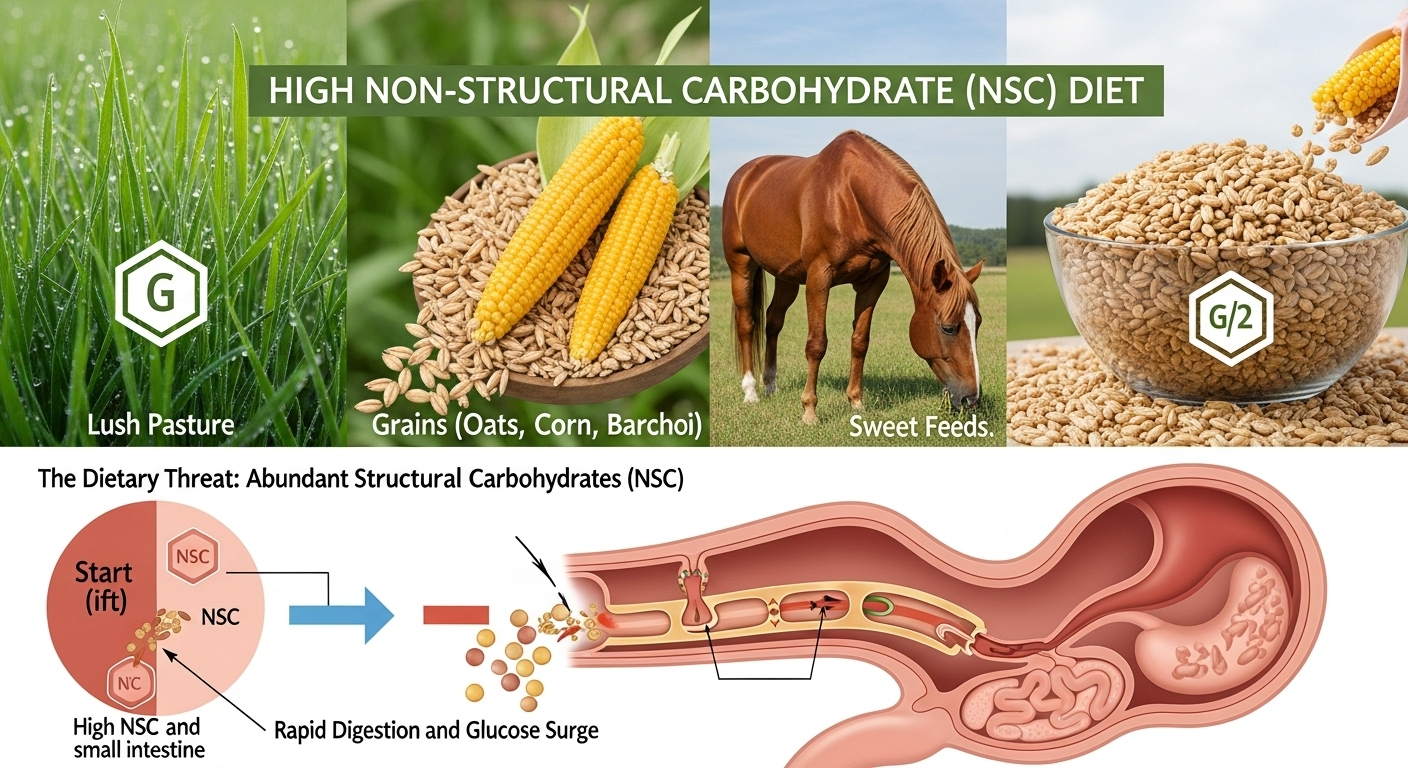Key Takeaways
- Horses with insulin dysregulation often benefit from hay with NSC levels below 10%, and ideally no more than 12%, to help prevent dangerous insulin spikes that can trigger laminitis
- Soaking hay for 30-60 minutes can reduce non-structural carbohydrates, with reductions varying between 25-50%, but individual horses show variations in NSC tolerance
- Research conducted at the University of Kentucky, using supplemental pure starch and sugar sources, has identified a threshold of approximately 0.1 grams of NSC per kilogram of body weight per meal, above which insulin-dysregulated horses exhibit significantly increased insulin responses
- Combining dietary management with moderate exercise and regular monitoring creates the most effective long-term strategy for horses with Equine Metabolic Syndrome
- While recent studies suggest protein levels in feed have minimal impact on post-meal insulin concentrations compared to carbohydrates, protein quality and amino acid profiles remain important for overall health during dietary restriction
NSC Content Below 10% Reduces Insulin Spikes in At-Risk Horses
The foundation of managing insulin resistance in horses lies in understanding how non-structural carbohydrates trigger dangerous metabolic responses. When horses consume feeds containing high levels of NSCs—which include sugars, starches, and fructans—their bodies respond with significant insulin spikes that can persist for hours. These elevated insulin levels create a cascading effect that damages the delicate structures within the hoof, potentially leading to the painful and often devastating condition known as laminitis.
Research demonstrates that maintaining forage NSC levels below 10%, and ideally no more than 12%, on a dry matter basis can be a safe threshold for horses diagnosed with Equine Metabolic Syndrome or those showing early signs of insulin dysregulation. This isn’t just a general recommendation—it’s based on measurable physiological responses that show dramatic differences in insulin production when horses consume lower-carbohydrate feeds. Hoof Room’s analysis of low-NSC feeding strategies reveals how proper carbohydrate management can transform the health outcomes for metabolically compromised horses.
The challenge lies not just in finding low-NSC hay, but in understanding that NSC content varies significantly based on cutting time, weather conditions, and storage methods. Morning-cut hay typically contains higher sugar levels than hay cut in late afternoon, while drought-stressed grasses concentrate their carbohydrates, creating unexpectedly high NSC levels even in traditionally “safe” grass varieties.
Understanding the Insulin-Laminitis Connection in EMS Horses
How Hyperinsulinemia Triggers Lamellar Damage
The mechanism by which elevated insulin levels cause laminitis involves complex cellular processes within the hoof’s laminar structures. When insulin concentrations remain chronically elevated—a condition called hyperinsulinemia—the normal signaling pathways within cells become disrupted. Instead of following the typical metabolic pathway that promotes healthy glucose uptake, cells shift toward the mitogen-activated protein (MAP) kinase pathway, which triggers cellular changes that compromise the structural integrity of the laminae.
This cellular disruption manifests first as stretching and elongation of the secondary epidermal lamellae, the microscopic finger-like projections that attach the hoof wall to the underlying structures. Studies using insulin infusion demonstrate that these changes begin within hours of sustained hyperinsulinemia, progressing to visible laminar damage within days. The insulin-like growth factor 1 (IGF-1) receptor appears to play a crucial role in this process, as high insulin concentrations can activate these receptors and trigger the damaging cellular cascade.
Why Traditional Feeding Approaches Fail EMS Cases
Conventional horse feeding practices often rely on grain-based concentrates and unlimited access to pasture—approaches that prove catastrophic for horses with insulin dysregulation. Traditional feeding schedules that include morning and evening grain meals create predictable insulin spikes twice daily, maintaining chronically elevated insulin levels that never allow the horse’s metabolic system to reset. Even seemingly innocent treats like carrots and apples contribute significant sugar loads that compound the problem.
Pasture management presents another critical failure point in traditional approaches. The common practice of turning horses out during daylight hours coincides with peak sugar accumulation in grasses, particularly during spring and fall when growing conditions optimize carbohydrate storage. Many horse owners unknowingly subject their EMS horses to the highest NSC exposure precisely when their metabolic systems are most vulnerable.
Proven Low-NSC Diet Implementation Strategies
Testing and Selecting Appropriate Forages
Implementing an effective low-NSC feeding program requires moving beyond guesswork to scientific analysis of feed components. Hay analysis through certified laboratories provides valuable NSC content measurements, costing approximately $25-50 per sample, which aids in making informed feeding decisions. These tests typically provide invaluable data on water-soluble carbohydrates, starch, and total NSC content. The investment pays dividends in preventing costly laminitis episodes that can cost thousands in veterinary bills and potentially end a horse’s career.
When selecting hay, look for mature grass hays cut during late afternoon hours when plant sugars are at their lowest concentrations. Timothy hay can often show lower NSC levels compared to other grass varieties, but NSC content varies based on cutting time and environmental conditions. Legume hays like alfalfa, despite their higher protein content, often maintain acceptable NSC levels below the critical 10% threshold. Avoid hays that appear overly leafy or green, as these characteristics often indicate higher carbohydrate content.
Proper Hay Soaking: 30-60 Minutes for NSC Reduction
Hay soaking represents one of the most effective tools for reducing NSC content in existing hay supplies. Research demonstrates that soaking hay for 30-60 minutes in cold water can remove a significant percentage of water-soluble carbohydrates, with some studies showing reductions between 25-50%, depending on the type of hay. However, the soaking process requires careful attention to detail—the soak water must be completely discarded, as it contains concentrated sugars and minerals leached from the hay.
Soaking duration matters significantly. Shorter soaking periods of 15-30 minutes provide moderate NSC reduction while preserving more nutritional value, making this approach suitable for horses with mild insulin sensitivity. Extended soaking beyond 60 minutes achieves maximum carbohydrate reduction but also removes important minerals and vitamins, requiring careful supplementation to prevent nutritional deficiencies. Water temperature affects the process as well, with warm water accelerating sugar extraction but potentially encouraging bacterial growth that can create food safety concerns.
Managing Pasture Access Without Compromising Nutrition
Strategic pasture management allows EMS horses to benefit from natural grazing behaviors while controlling their carbohydrate intake. Grazing muzzles reduce dry matter intake by 77-83% compared to unrestricted grazing, providing a practical solution for maintaining some pasture access. The key lies in understanding that time-restricted grazing alone proves insufficient—horses can consume substantial amounts of their body weight in just a few hours of unrestricted access.
Early morning turnout, typically before 10 AM, coincides with lower grass sugar levels accumulated during overnight hours. Evening grazing after 6 PM similarly provides access when plant carbohydrates are at their daily minimums. Strip grazing systems that rotate horses through small paddock sections prevent overconsumption while maintaining natural foraging behaviors that support psychological wellbeing.
Recent Research Reveals Critical NSC Thresholds
Individual Horse Variation in NSC Tolerance
Research conducted at the University of Kentucky, using supplemental pure starch and sugar sources, has identified a threshold of approximately 0.1 grams of NSC per kilogram of body weight per meal, above which insulin-dysregulated horses exhibit significantly increased insulin responses. This translates to approximately 50 grams of NSC per meal for a typical 1,100-pound horse. However, the research reveals striking individual variations in how horses respond to identical carbohydrate loads, with some horses showing dangerous insulin spikes at levels that don’t affect others.
These individual differences appear linked to genetic factors, previous laminitis history, and overall metabolic health status. Horses with a history of laminitis episodes demonstrate heightened sensitivity to even minimal NSC intake, while some horses maintain normal insulin responses despite consuming moderately higher carbohydrate levels. This variability underscores the importance of individualized feeding programs based on specific testing rather than blanket dietary recommendations.
High Protein Intake May Impact Insulin Response in Sensitive Horses
Recent studies have challenged long-held assumptions about protein’s role in insulin regulation among EMS horses. While initial research suggested protein content significantly influenced insulin responses, newer controlled studies demonstrate that protein levels have minimal impact on post-meal insulin concentrations. This finding shifts the focus back to carbohydrate management as the primary dietary intervention for insulin-sensitive horses.
However, protein quality and amino acid profiles still matter for overall health maintenance during dietary restriction. High-quality protein sources support muscle mass preservation during weight loss programs, while essential amino acids facilitate proper metabolic function. The research suggests that protein concerns shouldn’t override carbohydrate restrictions, but adequate protein intake remains important for supporting the horse’s overall nutritional needs during EMS management.
Beyond Diet: Exercise and Monitoring for Long-Term Success
Moderate Exercise Regimens That Improve Insulin Sensitivity
Exercise programs designed for EMS horses require careful balance between metabolic benefits and laminitis risk. Moderate-intensity exercise, defined as achieving heart rates between 110-150 beats per minute, provides optimal insulin sensitivity improvements without excessive concussive stress on compromised hooves. This translates to controlled longeing sessions at a working trot or light riding programs that gradually increase duration rather than intensity.
Research demonstrates measurable improvements in insulin sensitivity within days of beginning consistent exercise programs, with benefits persisting for several days after each session. The key lies in consistency rather than intensity—daily 30-minute sessions of moderate exercise prove more beneficial than sporadic high-intensity workouts. Swimming programs offer particular advantages for horses with active laminitis, providing cardiovascular conditioning without weight-bearing stress on damaged laminar structures.
Blood Work Monitoring Protocols
Successful EMS management requires systematic monitoring through specific diagnostic tests that track insulin regulation improvements over time. The oral sugar test (OST) provides the most practical field assessment, measuring insulin response to a standardized carbohydrate challenge. Elevated insulin concentrations, particularly those exceeding 45-65 μIU/mL at 60-90 minutes post-dosing in an oral sugar test, may indicate continued insulin dysregulation requiring dietary modifications; consult with a veterinarian for accurate diagnosis.
Monitoring frequency depends on the horse’s response to treatment and laminitis history. Horses showing initial improvement benefit from monthly testing for the first quarter, followed by quarterly assessments once stable responses are achieved. Horses with recurring laminitis episodes or poor initial responses may require more frequent monitoring to guide treatment adjustments. Additional markers including triglycerides and adiponectin levels provide complementary information about metabolic health improvements.
Low-NSC Feeding Transforms EMS Management When Applied Correctly
The transformation possible through proper low-NSC feeding strategies extends far beyond preventing laminitis episodes. Horses successfully managed on appropriate diets show improved energy levels, better body condition regulation, and quality of life improvements. The key lies in understanding that EMS management represents a long-term commitment requiring consistent application of multiple strategies rather than quick fixes or temporary dietary changes.
Success stories consistently involve horse owners who commit to approaches combining proper forage selection, strategic feeding schedules, appropriate exercise programs, and regular veterinary monitoring. These horses often return to productive riding careers and maintain stable health for years following their initial diagnosis. However, the management protocol must continue indefinitely, as insulin dysregulation represents a chronic condition requiring ongoing attention rather than a temporary problem to be solved.
The future of EMS management lies in increasingly personalized approaches based on individual testing and response monitoring, moving away from one-size-fits-all dietary recommendations toward targeted interventions tailored to each horse’s specific metabolic profile.
For guidance on implementing low-NSC feeding strategies and understanding ingredient sensitivities in EMS horses, visit Hoof Room, where expert analysis helps horse owners navigate the complexities of equine metabolic health management.


Comments are closed.